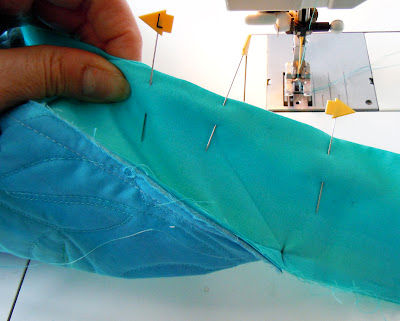segunda-feira, maio 27, 2013
segunda-feira, janeiro 07, 2013
http://paintedthreadsprojects.blogspot.com.br/2011/04/making-faced-binding.html
s.
SATURDAY, APRIL 16, 2011
Making a Faced Binding
Quite often I think bindings can visually distract from an art quilt. Of course there are times when the binding integrates visually to the overall design of a quilt and is a necessary design element. But for my quilts I find a frame of color around the outside edge of the quilt to be distracting. I don't really like big wooden frames on painted canvases either, so I guess that is just my personal preference.
So, when I make large art quilts, I like to make faced bindings, which creates a very clean finish to the front of a quilt (and you can never get a critical comment from a judge that your binding is not evenly filled either, lol).
The first thing you need to do is cut a four inch wide strip of fabric for each side of the quilt that is about 4" longer than each side.
Fold the fabric in half lengthwise and press.
After I have trimmed the quilt to size, I machine stitch the edge to secure any quilting lines that have been cut and to keep the 3 layers secured while sewing the binding on.
Pin the binding fabric to the front of the quilt with a couple extra inches of binding at either end.
With a pencil place a mark 1/4" from the top edge of the quilt, do the same at the bottom edge of the quilt. This is where you will begin and end stitching. Stitch binding down with 1/4" seam allowance.
Fold the binding back at a 45° angle, place the next binding down and repeat the previous step.
Finger press the second binding at a 45° angle.
This finger pressed line will be your stitching line.
Bring the two binding edges together, matching up the finger pressed lines and pin.
Pull the quilt out of the way and stitch along the finger pressed line.
Stop stitching at the pencil mark.
Trim seam to 1/4" and finger press open.
Trim bulk of seam allowance away at corner being careful not to cut the stitching line.
So, when I make large art quilts, I like to make faced bindings, which creates a very clean finish to the front of a quilt (and you can never get a critical comment from a judge that your binding is not evenly filled either, lol).
The first thing you need to do is cut a four inch wide strip of fabric for each side of the quilt that is about 4" longer than each side.
Fold the fabric in half lengthwise and press.
After I have trimmed the quilt to size, I machine stitch the edge to secure any quilting lines that have been cut and to keep the 3 layers secured while sewing the binding on.
Pin the binding fabric to the front of the quilt with a couple extra inches of binding at either end.
With a pencil place a mark 1/4" from the top edge of the quilt, do the same at the bottom edge of the quilt. This is where you will begin and end stitching. Stitch binding down with 1/4" seam allowance.
Finger press the second binding at a 45° angle.
This finger pressed line will be your stitching line.
Bring the two binding edges together, matching up the finger pressed lines and pin.
Pull the quilt out of the way and stitch along the finger pressed line.
Stop stitching at the pencil mark.
Trim seam to 1/4" and finger press open.
Trim bulk of seam allowance away at corner being careful not to cut the stitching line.
Trim the seam allowance at an angle toward the corner.
Turn the binding to the back, poking the corner out to a point with your finger or with a blunt pointed object. Press the binding along the edge of the quilt with a hot iron. Then slip stitch the binding to the back of the quilt.
A nice clean finish!
Etno Botânica: PELES – COURO – MODA - A MATANÇA DE ANIMAIS E O C...
Etno Botânica: PELES – COURO – MODA - A MATANÇA DE ANIMAIS E O C...: O que é "invisível" aos olhos nestes belos Casacos de Peles, bolsas e calçados em couro. A medida em que adiamos olhar para e...
Etno Botânica: Índigo Natural – O Azul de Origem Vegetal
Etno Botânica: Índigo Natural – O Azul de Origem Vegetal: Matéria-prima: O extrato natural de Índigo pode ser obtido a partir da fermentação das folhas de várias espécies de anileiras como por ex...
Assinar:
Comentários (Atom)















